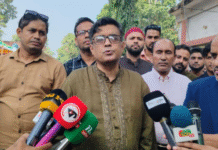
A man works on the roof a house submerged in flood water as severe flooding pushes people to adopt a different way of living amid adversity of nature. The photo was taken at Char Kabilpur in Gaibandha on Tuesday. — Focusbagla photo
Millions of people, marooned by floods, evacuated themselves to schools, embankments, and highways in northeastern districts for shelter in last couple of days.
The marooned are struggling to cope with untold sufferings being caused by non- availability of food, drinking water and medicines.
Passing their days under the open sky, women, children and elderly people became more vulnerable as rains made life harder.
In the worst affected districts under the Rangpur and Rajshahi divisions, in particular, people had to leave homes, under waters, to shelter elsewhere.
Outbreaks of typhoid, dysentery, diarrhea and other water borne diseases in Lalmonirhat district increased people’s sufferings sans medical treatment and relief supplies, reported our correspondent.
By Tuesday, death toll, caused by flood related issues, rose to 48, according to reports sent by New Age correspondents.
In Dinajpur alone at least 26 villagers died and the victims included women and children, our correspondent reported.
Disaster Management Department’s control room director Abu Taleb told New Age that flood related causes claimed six lives in Kurigram, five each in lalmonirhat and Nilphamari, two each in Chapainawabganj and Sunamganj and one in Moulvibazaar.
Dislodged by floods, Rokeya Begum of Mugulhat, Sadar upazila, Lalmonirhat, told New Age correspondent in Lalmonirhat that she left home with her husband and two minor children six days ago leaving all their belongings behind.
She said that her home had been devoured by floods caused by the Teesta in spate.
She said that her family was passing days without food and drinking water.
Several victims in Kurigram Sadar upazila said that they spent the last three days living on the local helipad under the open sky.
They said that no better shelter was available to these beleaguered families as the shelter homes in the area became over crowded with other shelter less people.
Until now, no relief supplies reached the area, said Rajpur union parishad chairman Mofazzal Hossain.
Rajpur union is in Sadar upazila of Lalmonirhat.
‘We simply got nothing as corrupt local officials took all relief materials home,’ said marooned villagers.
But Department of Disaster Management director for relief operations in the capital Ifthekharul Islam told New Age that the government was providing relief supplies to people in all the flood affected districts.
The floods aggravated in the northern districts and engulfed new districts of Rajbari, Manikganj and Shariatpur, in the country’s middle region, as the Jamuna and the Ganges passing by them overflowed, according to the Water Development Board.
The flooding aggravated in the worst affected districts of Dinajpur, Kurigram, Lalmonirhat, Gaibandha, Jamalpur, Sirajganj, Rajshahi, Rajbari, Manikganj, Shariatpur and Munhsiganj.
The army deployed three more platoons in Gaibabdha to repair embankments damaged by the Jamuna.
The army sent a team to worst affected areas in Kazipur upazila, Sirajganj to see the ground realities in the area.
Flood Forecasting and Warning Centre said that the state of flooding remained unchanged in the northern districts but more areas in the country’s middle were inundated.
Power supply disruption continued to cause additional sufferings to thousands of people in Kurigram, Lalmonirhat and Dinajpur as their worst affected areas reeled four to five feet under flood waters.
Power utility officials said severely damaged roads obstructed restoration of power supply in the areas.
Source: New Age









